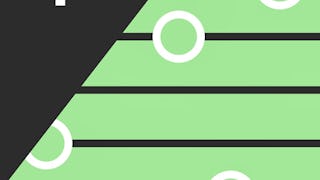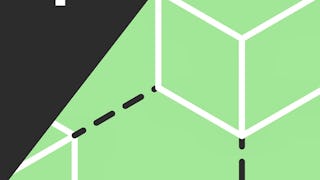This intermediate-to-advanced course guides learners through the structured development of procedural surface systems in Unity using noise-based methods. Through six focused modules, participants will explore dimensional noise functions, gradient masks, resolution control, derivative computation, and flow visualization using particle systems and scripting.

Discover new skills with 30% off courses from industry experts. Save now.


Unity: Design Procedural Surfaces with Noise Functions
This course is part of Unity Procedural Generation & Game Mechanics Specialization

Instructor: EDUCBA
Included with 
Skills you'll gain
Details to know

Add to your LinkedIn profile
August 2025
18 assignments
See how employees at top companies are mastering in-demand skills

Build your subject-matter expertise
- Learn new concepts from industry experts
- Gain a foundational understanding of a subject or tool
- Develop job-relevant skills with hands-on projects
- Earn a shareable career certificate

There are 6 modules in this course
This module introduces learners to the foundational concepts and practical setup for procedural noise generation in Unity. It covers the theory of noise, setting up a visual platform using quads, interfacing with the Texture Creator script via the Inspector, and understanding wrap modes. It also delves into how spatial transformations and resolution settings influence texture output and how deterministic methods like value duplication can ensure consistent sampling. By the end of this module, learners will have built the groundwork for more advanced procedural content systems by manipulating and configuring 2D texture behaviors programmatically.
What's included
7 videos3 assignments
This module introduces flexible programming constructs and foundational techniques for generating procedural noise in Unity. It begins with the use of delegates to abstract and pass custom noise functions dynamically, enabling modularity and reusability. Learners explore how to structure 2D and 3D float-returning functions to generate procedural values. The module then builds toward implementing Perlin noise and customizing value methods, culminating in the use of gradient masks to shape surface influence. These techniques provide the backbone for flexible, scalable procedural content systems that respond to both spatial and runtime dynamics.
What's included
6 videos3 assignments
This module focuses on customizing the spatial characteristics and complexity of procedural textures in Unity by manipulating texture dimensions, frequency, and layered noise. Learners will explore how to define texture resolutions, apply both 2D and 3D gradient masks for localized control, and refine procedural results through frequency scaling. The module concludes with the use of octaves to layer multiple noise functions for more realistic and organic outcomes, culminating in the creation of an isolated surface scene for controlled testing and visualization of procedural systems.
What's included
5 videos3 assignments
This module guides learners through the construction and refinement of procedural surfaces using Unity’s mesh manipulation and noise application systems. It covers how to generate a custom mesh grid, apply noise to create terrain-like displacement, and fine-tune results through parameters such as resolution, strength, and offset. Learners will also implement responsive update mechanisms using refresh methods, allowing real-time control and visualization of procedural changes. By the end of this module, learners will have built a flexible and adjustable system for generating dynamic surfaces in 3D space.
What's included
6 videos3 assignments
This module introduces the concept of sampling and derivatives in procedural noise systems to enhance visual detail and control in surface generation. Learners will explore how to extract directional information from noise fields, encapsulate both values and gradients using custom data structures, and implement static and dynamic noise samples for debugging and consistency. The module further covers how derivatives are computed for both value and Perlin noise, including the use of analytical methods to efficiently derive slope and flow characteristics in 2D and 3D spaces.
What's included
6 videos3 assignments
This module focuses on converting procedural noise data into dynamic visual representations by integrating flow fields, derivative smoothing, and particle systems. Learners will validate noise type compatibility, smooth derivative transitions to improve surface continuity, and build flow visualization components that convey direction and intensity using visual elements. Through the use of particle trails, GameObjects, and scripting, the module teaches how to express flow dynamics in 3D environments using Unity’s rendering and scripting systems.
What's included
6 videos3 assignments
Earn a career certificate
Add this credential to your LinkedIn profile, resume, or CV. Share it on social media and in your performance review.
Explore more from Design and Product

Coursera Project Network
 Status: Preview
Status: PreviewThe University of Tokyo
 Status: Free Trial
Status: Free Trial
Why people choose Coursera for their career





Open new doors with Coursera Plus
Unlimited access to 10,000+ world-class courses, hands-on projects, and job-ready certificate programs - all included in your subscription
Advance your career with an online degree
Earn a degree from world-class universities - 100% online
Join over 3,400 global companies that choose Coursera for Business
Upskill your employees to excel in the digital economy
Frequently asked questions
To access the course materials, assignments and to earn a Certificate, you will need to purchase the Certificate experience when you enroll in a course. You can try a Free Trial instead, or apply for Financial Aid. The course may offer 'Full Course, No Certificate' instead. This option lets you see all course materials, submit required assessments, and get a final grade. This also means that you will not be able to purchase a Certificate experience.
When you enroll in the course, you get access to all of the courses in the Specialization, and you earn a certificate when you complete the work. Your electronic Certificate will be added to your Accomplishments page - from there, you can print your Certificate or add it to your LinkedIn profile.
If you subscribed, you get a 7-day free trial during which you can cancel at no penalty. After that, we don’t give refunds, but you can cancel your subscription at any time. See our full refund policy.
More questions
Financial aid available,


